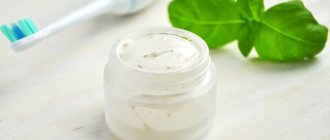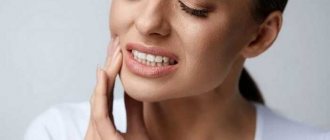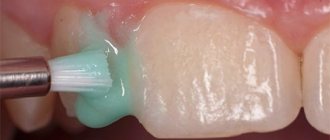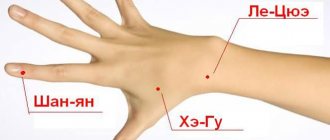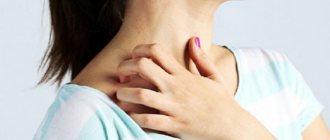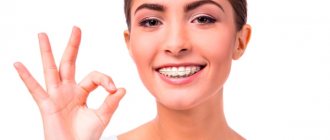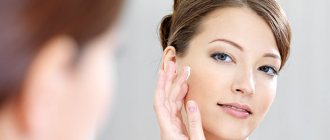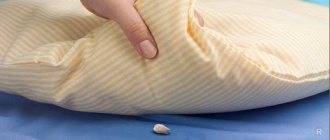An allergy is a hypertrophied immune response of the body to external and internal stimuli. Allergens can include food, dust, animal hair, cosmetics, household chemicals, medications, etc. Allergy to toothpaste is a common phenomenon that many people encounter every day.
It is noteworthy that signs of an immune reaction to a given product are not always localized directly in the mouth area. Thus, characteristic rashes can appear on the skin of the face and neck, mucous membranes; in severe cases, the consequences of the body’s immune response to toothpaste can even affect the functioning of internal organs.
Allergens
The answer to the question of whether individual components of toothpastes can cause an increased immune response in the body is positive. In this case, the role of “provocateurs” is played by both natural ingredients (mint, menthol) and artificial additives (flavors, preservatives, etc.).
Do not squeeze out too much paste for one cleaning - a small pea of the therapeutic and prophylactic product can cope with all dental tasks
Fluoride is considered to be the most common allergen in toothpastes, but in addition to it, parabens, essential oils, papain, sodium benzoate, propylene glycol can lead to the appearance of rashes, irritation, swelling and other typical symptoms. In addition, bleaching agents and antibacterial additives (triclosan, zinc nitrates, chlorides) can provoke a reaction.
Important! The cause of allergies in children and adults can be not only the toothpastes themselves, but also other products intended for daily oral care:
- dental floss;
- rinses (balms);
- chewing gum.
True, most dentists claim that if you follow the instructions for using such products, no side effects should occur.
How to determine natural toothpaste by composition
The following components can be found in the organic paste:
- Herbs (calendula, ratania, coltsfoot, oak bark, chamomile, string, sage, echinacea), tea tree essential oil, clay and propolis fight microbes and help relieve inflammation.
- Minerals (calcium, silicon) strengthen the enamel.
- Salt protects against the formation of plaque and tartar and relieves inflammation.
- Lemon oil whitens enamel.
- Essential oils of fennel, mint, and eucalyptus provide fresh breath.
To make the paste pleasant to taste and easy to use, add to it:
- Natural sweeteners from rowan leaves, fibers of vegetables and fruits, citrus fruits, algae;
- Dyes from juice and extracts from plants (for example, when adding dye from geranium, the paste acquires a pink tint);
- Thickeners from molasses and rowan extracts.
Sometimes preservatives are added to organic pastes, but their content is minimal. They are needed so that the paste has the right consistency and so that it can be stored longer.
Types of reactions
Symptoms of toothpaste allergy take several clinical forms:
Reviews of White Glo toothpaste
- Contact dermatitis. Manifestations: rashes in the corners of the mouth, around the lips.
- Rash on eyelids. Signs: multiple red small pimples that itch intensely. If left untreated, the rashes “go down” and cover the cheeks, chin, ears, and neck. This reaction is the body’s response to the fluorides contained in toothpaste.
- Ulcers, wounds on the oral mucosa, gums. They create significant discomfort during eating and swallowing.
- Cheilitis. The main “identifying sign” of an allergy to toothpaste. Characteristic symptoms are dryness, irritation, cracking of the skin around the lips, damage to the mucous membrane. In advanced cases, soft tissues swell and purulent discharge appears.
Important! An allergy to toothpaste can also reach the gastrointestinal tract (if a certain amount of this hygiene product is swallowed during brushing). In this case, the victim of an allergic reaction is faced with the following manifestations: abdominal pain, stool upset, flatulence.
Classic manifestations of childhood allergies are not only rashes on the mucous membranes and around the mouth, but also general weakness and increased body temperature
What other symptoms can result from an allergy to toothpaste? These are difficulty breathing, urticaria, conjunctivitis (hyperemia, swelling, itching of the eyelids), inflammation of the gums, anaphylactic shock.
Signs of childhood allergies
Due to the characteristics of the immature immune system, the child’s body may react to the action of toothpastes somewhat differently. So, in addition to the classic itching, rash, swelling, inflammation, young children develop weakness, apathy, tearfulness and other systemic manifestations.
Typical symptoms of toothpaste allergy in children:
- redness of the skin on the face;
- burning sensation in the mouth;
- weakness, lethargy, moodiness;
- digestive disorders;
- increased body temperature;
- drowsiness;
- irritation of the skin around the lips and oral mucosa.
Diagnostics
To identify the cause of an allergic reaction, the doctor takes an anamnesis, examines the patient, sends him for skin tests, a blood test for immunoglobulins and special tests. Thus, taking blood from a vein is necessary to identify signs of an inflammatory process in the body and determine its general allergization.
To avoid unwanted reactions, dentists recommend choosing toothpastes with minimal fluoride content and soft brushes with medium-length hairs.
Important! The main diagnostic indicators are the level of lymphocytes, as well as immunoglobulin E (if the latter is elevated, there is an acute or chronic allergic reaction in the body).
During skin testing, a small amount of a “suspect” substance is injected under the skin of the person being tested and subsequent reactions are monitored. If this type of diagnosis does not demonstrate the desired result, the patient is sent for an elimination (provocative) test. Its essence lies in the introduction of a substance - an allergen - directly under the mucous membrane. The procedure is performed exclusively in a hospital setting under the supervision of a physician.
The main signs of an allergy to toothpaste
Allergic manifestations occur in people of different ages and professions. Unpleasant symptoms may appear after eating certain foods, contact with chemicals, inhaling strong odors, and other things. An exception in this sense is an allergy to toothpaste - this condition affects children and adults.
It is impossible to completely eliminate oral care products, because the condition of the entire body depends on the health of the teeth.
The main reason for the development of an allergy to toothpaste is the development of a pathological reaction of the immune system to one of the components of the product. When choosing a teeth cleaning product, pay attention to the composition given on the packaging.
Often allergies appear to the following substances:
- Dyes, flavors, preservatives.
- Sodium lauryl sulfate. This substance is added to products to enhance foaming. At the same time, it can cause serious allergic reactions that affect the respiratory system.
- Fluorine. This component is contained in almost all adult toothpastes, since without it, complete protection of tooth enamel and the fight against caries is impossible.
- Bleaches. To more effectively remove plaque and prevent the formation of tartar, the pastes contain special abrasive substances.
- Antibacterial components to remove pathogenic microorganisms: chlorides, triclosan. Often these substances provoke allergies.
- Nitrates, potassium and citrates create an invisible protective layer on the tooth surface. Such substances are often included in barrier pastes.
Important! If you are predisposed to allergies, you should be careful with products with a strong odor and bright color.
Symptoms
An allergy to a dentifrice does not only have external signs; often the symptoms also affect internal organs. The defense system also suffers, which causes serious deviations in the functioning of the entire body. In this case, allergies can begin quickly or intensify gradually as harmful substances accumulate.
Symptoms of a toothpaste allergy
- Contact dermatitis. In this case, a rash appears around the mouth and seizures in the corners. In the absence of effective treatment, unpleasant symptoms can spread throughout the body. Itching and rash may occur, affecting not only the area of direct contact with the paste, but also the nose, cheeks, and chin.
- Formation of wounds on the mucous surfaces of the mouth and gums. Such areas are characterized by soreness, which increases after brushing teeth and eating. An allergy to toothpaste in a child is especially dangerous, since children cannot accurately describe what and where it hurts, they simply behave restlessly and are capricious.
- Inflammation of the lips (cheilitis) in which the skin becomes pale, dry and cracked. In advanced situations, there is a risk of swelling and purulent discharge.
- Intestinal manifestations. Since a small amount of toothpaste can enter the gastrointestinal tract, the allergy also affects internal organs. In this case, the pathological reaction is characterized by burning pain, bloating, frustration, exacerbation of chronic gastritis, and so on.
- Problems with the respiratory system, which often accompany allergic reactions. Severe swelling of the larynx, tongue, cheeks can cause deterioration in air flow. If left untreated, there is a high likelihood of developing angioedema and anaphylaxis.
Along with specific symptoms, an allergy to dental care products can also be accompanied by general symptoms, such as hyperthermia, sleep disturbance, and fatigue.
Features of manifestation in children
Despite the fact that the symptoms of an allergy to toothpaste are similar in childhood and in adults, sometimes the child’s body reacts specifically to the components of the product. In this case, the pathological reaction is accompanied not only by rashes, itching and hyperemia, but also by general malaise. The main signs of allergies in children are:
- severe redness on the face;
- burning in the mouth;
- drowsiness, lethargy;
- fatigue, moodiness;
- upset stool, nausea;
- moderate hyperthermia;
- inflammation of the mucous membrane and skin around the mouth.
Unlike adults, an allergy to toothpaste poses a great danger for a child. Serious complications are possible in the form of:
- metabolic problems;
- occurrence of dermatitis;
- difficulty breathing, shortness of breath;
- diseases of the oral cavity, for example, stomatitis;
- inflammation of the gums (gingivitis);
- redness, rash and blisters on the face.
Diagnostics
In order for a specialist to be able to prescribe effective treatment that can reduce unpleasant symptoms and painful manifestations, as well as minimize the risk of developing dangerous complications, it is necessary to identify and eliminate the cause of the allergic reaction. After interviewing the patient and a detailed study of the medical history, a number of diagnostic procedures should be carried out, for example, a blood test for immunoglobulins, skin allergy tests, and special tests.
Blood analysis
Blood is taken from a vein to identify the inflammatory process, as well as determine the level of general allergization of the body.
Important diagnostic parameters in this case are the level of lymphocytes and immunoglobulin E. Its increased amount indicates the presence of an allergy.
This method is quite informative, but cannot indicate which particular component of the dental care product caused the development of the pathological process.
Skin tests
Most often, skin tests are performed to identify the allergen. This analysis allows you to accurately determine which component of the toothpaste a specific response of the immune system develops to. In this case, using a special subcutaneous injection or scratch with a scarifier, a small amount of the suspected allergen is introduced and a local reaction of the body to the irritant is observed.
It should be remembered that no more than fifteen samples can be made in one session. If severe redness, swelling or itching occurs at the site of contact, we can talk about the presence of an allergy to this substance.
Important! Skin tests are bloodless, painless, safe and at the same time one of the most informative ways to determine allergies.
Elimination and provocation test
There are situations when even skin tests do not allow us to determine which particular drug caused the allergic reaction. In this case, special tests are used.
Provocative tests are most often carried out in a hospital setting, as they are dangerous due to the occurrence of severe reactions. In the process, the suspected allergen is introduced directly onto the mucous membrane, which makes it possible to determine the presence or absence of a specific response of the body to this substance.
One of the safe diagnostic methods is elimination tests. They are carried out in situations where contact with the stimulus is permanent.
To determine the allergen, hazardous substances are eliminated one by one. If replacing regular toothpaste with a product with a different composition does not give a positive effect within one to two weeks, then the test continues.
The patient replaces the medications until a positive result is achieved.
Treatment
Effective therapy for any allergy should first of all be based on excluding the cause of the pathological reaction. If it is possible to establish that unpleasant symptoms arose after contact with the paste, you should change the drug and begin treatment immediately to avoid complications.
Antihistamine
In case of development of allergic stomatitis or cheilitis with intolerance to some components of the paste, antihistamines are prescribed.
They allow you to reduce the manifestation of negative signs in the oral cavity and other parts of the body, reducing inflammation, eliminating swelling, itching, and rashes. They use drugs such as Eden, Loratadine, Diazolin, Suprastin, etc.
In more severe situations, when standard remedies do not have the desired effect, hormone-containing drugs in the form of ointments and sprays (Hydrocortisone, Prednisolone) are used.
other methods
Allergies are often accompanied by abnormalities in the functioning of other important systems of the body. In this case, therapy may be required to eliminate associated symptoms:
- Agents that have a local anti-inflammatory effect. In this case, use a balm, gel or ointment that helps reduce irritation and heal small wounds and cracks (Actovegin, Cholisal, Kamistad-gel).
- Disinfectants intended for external treatment of problem areas (Miramistin).
- Medicines that accelerate healing (sea buckthorn oil, vitamin A).
- In case of severe pain at the site of wound formation or high temperature (most often in children), analgesics are used, for example, Ibuprofen or Paracetamol.
- To restore weakened immunity, special vitamin complexes are prescribed (Duovit, Undevit, Alphabet).
- If toothpaste has been swallowed and the allergy has affected the gastrointestinal tract, you should cleanse the body and reduce the level of intoxication. For this purpose, sorbents are used (White coal, Enterosgel).
General recommendations
To minimize allergic manifestations, you should follow some simple recommendations when brushing your teeth:
- after the cleaning procedure, thoroughly rinse your mouth to remove any remaining product and rinse the corners of your lips;
- give preference to hypoallergenic toothpastes with minimal fluoride content;
- use a small amount of product;
- Supervise children to ensure that foam and remaining paste are not swallowed.
Dentists recommend brushing your teeth twice a day to keep them healthy and looking attractive. However, in order for cleaning the oral cavity to bring only positive results, you should carefully choose toothpaste, excluding dangerous substances.
Nadezhda Chernobay
Sources: medscape.com, mdlinx.com, health.harvard.edu.
Source: https://roddom32.ru/byt/zubnaya-pasta.html
Solution
How to cope with the consequences of the body's allergic response to toothpaste: the best thing is to seek help from a dentist, who will determine the allergen that caused the reaction and select the correct complex therapy. Usually, to combat the consequences of allergies, drugs are used - enterosorbents and, of course, antihistamines (Diazolin, Telfast, Claritin, Diphenhydramine, Tavegil). The dosage and type of medications are selected by the doctor.
Symptomatic therapy for an allergic reaction to toothpaste:
- local anti-inflammatory drugs (ointments, gels, aerosols) - Cholisal, Actovegin, Kamistad-gel.
- Antiseptics for treating mucous membranes (Miramistin).
- Vitamin A, sea buckthorn oil and other agents that accelerate wound healing.
- In cases of severe pain and increased body temperature, patients are prescribed analgesics (Paracetamol, Ibuprofen).
- Vitamin complexes to combat immune dysfunction (Alphabet, Undevit).
Important! To combat local allergy symptoms, it is advisable to use Metrogyl Denta paste, a drug with antiseptic, anti-inflammatory, antihistamine and wound-healing properties. This remedy is applied to wounds (ulcers) on the mucous membrane 2-3 times a day until they completely disappear.
Dentists say that improper use of dental floss and mouth rinses can also lead to rashes, irritation of the mucous membranes and cause inflammation of the gums
For allergy symptoms from the gastrointestinal tract, you can use proven folk recipes:
- pomegranate juice copes well with diarrhea, nausea, abdominal pain and other discomfort in the digestive tract;
- You can make this healthy cocktail at home: 1 tbsp. l. mix tomato juice with 1 tsp. ginger, add ½ tsp. salt and lemon juice. This remedy will help to get rid of allergic manifestations as soon as possible, improve well-being, and restore the functioning of the gastrointestinal tract.
Possible complications
If treatment measures are not taken in a timely manner, allergies can result in: severe forms of dermatitis, inflammation of the gums, an increase in the number of wounds on the oral mucosa and around the lips, increased sensitivity of soft tissues (gums, cheeks, tongue), respiratory dysfunction, metabolic disorders, problems with the immune system. .
For children, an allergic reaction to the components of toothpaste is even more dangerous and can provoke the following unpleasant consequences: metabolic disorders, shortness of breath, dermatitis, chronic infectious and inflammatory diseases of the oral cavity, the appearance of various rashes on the face (from small pimples to large blisters).
Precautionary measures
People with increased sensitivity of the oral mucosa may experience symptoms clinically similar to an allergic reaction to toothpaste components after brushing their teeth. So, after changing this hygiene product, signs of inflammation, irritation and other uncomfortable sensations may appear.
Dentists recommend that such patients opt for brands of toothpastes that use a minimum amount of essential oils and flavoring additives (Sensodyne, Oral-B) in their production. Another useful advice from doctors for allergy sufferers is that you should not press too hard on your gums with a brush while brushing your teeth. It is better if the villi are soft and of medium length.
Hypoallergenic toothpaste does not contain fragrances, taste enhancers and other natural (synthetic) components that can cause rashes and irritation
How can you tell if your child is allergic to toothpaste?
› Preschool age
11.01.2019
An allergy to toothpaste in a child is not detected as often as, for example, an allergy to food or pollen from flowering plants. How can you tell if your baby is intolerant to a hygiene product?
Allergy to toothpaste in a child
An allergy is a negative reaction of the body to irritants. Manifests itself in various ways:
- rash;
- tearfulness;
- red spots on the body;
- the appearance of excess mucus in the sinuses;
- Quincke's edema.
Some people may decide that the body's pathological reaction to a stimulus does not entail any serious consequences. This is wrong. Increased sensitivity can even lead to death if the reaction is not stopped in time.
Features of allergies to toothpaste in a child
For children, paste intolerance is dangerous in the following ways:
- metabolic disease;
- frequent dermatitis;
- dyspnea;
- breathing complications;
- diseases of the oral mucosa;
- frequent inflammation of the gums;
That is why it is so important to eliminate the allergic reaction in a timely manner.
Symptoms of a toothpaste allergy in a child
How does an allergy to the use of toothpaste manifest in a child? Allergy to toothpaste in a child symptoms:
- inflammation of the oral cavity;
- burning in the mouth;
- redness on the face;
- drowsiness;
- diarrhea;
- vomit;
- hyperthermia;
- moodiness;
- cheilitis – irritation, dryness and cracking of lips;
- conjunctivitis;
- hives.
When the attending physician has made a diagnosis, the baby is sent for tests. This is necessary to identify the cause of the disease.
Diagnostics include the following:
- Questioning the patient and studying the anamnesis.
- Blood analysis. Necessary for detecting inflammation in the body. The main indicators are the level of immunoglobulin and lymphocytes. A blood test does not show which component caused the negative reaction, but does provide information about the presence of an allergy.
- Skin tests. The most accurate way to identify the cause of the pathological process. A small amount of a likely irritant is injected under the skin and the local reaction is monitored. The procedure is practically painless. You cannot do more than fifteen samples in one procedure. If swelling, redness or itching occurs at the point of injection of one of the components, the allergen has been identified.
- If skin tests do not bring the desired result, there are extreme methods: provocative and elimination tests. Tests are carried out in stationary mode, because the likelihood of severe negative reactions is high.
Attention! The symptoms in children and adults are largely similar, but in children, intolerance to the hygiene product is more severe.
Provocative test - a possible irritant is applied to the mucous membrane to identify pathological reactions. An elimination test is a less dangerous method. With this test, potential allergens are gradually eliminated. The body's reaction is observed over a period of two weeks. Elimination is performed until the required result is achieved.
How to prevent
To prevent the development of complications, you must adhere to simple rules:
- After brushing, rinse your mouth very carefully, paying special attention to the corners of your mouth.
- For a baby, a pea-sized drop of paste is enough. If there is too much hygiene product, the risk of an allergic reaction increases.
- If, after brushing your teeth, redness appears, your gums become swollen, or the corners of your lips become chapped, immediately discard the product and contact your pediatrician.
It is necessary to carefully study the composition of the hygiene product. If it contains fluoride, cocamidopropyl betaine, propylene glycol or sodium benzoate, it is better not to use this product to clean your child's teeth.
During hygiene procedures, parents should always be close to the baby and monitor the process.
Treatment of allergies to toothpaste
If negative reactions are detected, the first thing you should do is consult a doctor. And the attending physician will refer you for tests and prescribe the correct treatment. It is important to know that test results may be unreliable for up to three years, so doctors do not recommend conducting research.
Methods to prevent toothpaste allergies
To prevent negative reactions, it is better to use hypoallergenic hygiene products. There is no need to use a paste containing herbs. Plant components very often cause irritation.
Toothpaste allergy medications
Depending on the severity of the reaction, various medications are used to treat symptoms:
- against itching and rashes on the skin, special ointments are used - “Hydrocortisone”, “Prednisolone” and others;
- to cleanse the body of irritants, enterosorbents are prescribed - activated carbon, white carbon or Enterosgel;
- to reduce the temperature, use drugs whose main substance is ibuprofen or paracetamol;
- an antihistamine is necessarily prescribed - “Loratadine”, “Edem”, “Suprastin” and others;
- to increase immunity, vitamin complexes are used: “Alphabet”, “Duovit” and so on;
- To treat inflamed areas externally, it is worth using Miramistin.
To speed up the healing of wounds and ulcers, vitamin A or sea buckthorn oil is prescribed.
Irritations that are not related to toothpaste allergies
There are often cases when irritation in the oral cavity occurs not due to intolerance to the hygiene product. Parents change one paste after another, but the irritation does not go away. A possible reason is that the brush is too hard. In this case, it is better to change the brush to another one with softer bristles.
If the problem is not the brush, then you should use a cleanser from certain brands that contain minimal amounts of essential oils and various flavorings. You should ask your dentist about such toothpastes.
It is important to explain to your child that you should not press the brush too hard on the gums and teeth, as this leads to swelling and bleeding.
Prevention
When brushing your teeth, in order to avoid negative consequences, it is recommended to follow a few simple rules:
- rinse your mouth thoroughly with running water (including the corners of your lips);
- toothpaste should be hypoallergenic with a minimum “portion” of fluoride in the composition;
- Do not swallow oral hygiene products.
So, a competent choice of toothpaste and its correct use can minimize the risk of an allergic reaction to individual components in the product. If symptoms indicating the body’s immune response nevertheless appear, you should immediately seek medical help from a dentist.
Allergy to toothpaste: what are the symptoms, at what age can a child brush his teeth?
Should baby teeth be brushed? This is a question many young parents ask. It’s hard to believe that it makes sense to spend energy caring for “temporary” teeth that will eventually fall out anyway, but what do doctors think about this? What consequences can parental inaction have for the baby’s health?
Dental care from infancy
It has been proven that the health of permanent teeth largely depends on how carefully their milk “predecessors” were cared for. For caring parents, this is a reason to think about how exactly they will provide for the hygiene needs of their child.
What you need to know about oral care during infancy? There is only one “secret”: you should gradually accustom your child to brushing his teeth from the very first days of his life. This is the only way to guarantee that the little man will not have dental problems in the future. Where should you start?
The baby is born toothless, but this does not mean that his mouth does not need to be cleaned. Infants (and, even more so, those who drink from a bottle “artificially”) come into forced contact with many harmful bacteria every day.
Entering the body along with food, pathogens of dangerous diseases are able to live in the oral cavity for months, assimilating lactose that is not intended for them and actively multiplying.
If the parents of the baby do not take timely preventive measures, childhood diseases (caries, stomatitis, gingivitis and candidiasis) will not keep you waiting long.
INTERESTING: Should you brush your teeth before or after breakfast?
You need to wash your hands with soap, moisten a clean gauze cloth in warm boiled water and wipe your gums with it. It is advisable to repeat this simple procedure every time after the baby eats if he does not fall asleep.
The described procedure is enough to maintain the health of the baby’s oral cavity, but only until the baby’s teeth begin to cut at 6–8 months. From this moment on, another line appears in the extensive list of responsibilities of young parents: “cleaning children’s teeth.”
When can you use a toothbrush and toothpaste?
Baby teeth that have barely erupted already require regular and thorough cleaning with special tools. A standard brush will not work: its hard bristles can injure fragile enamel and the delicate mucous membrane of the gums. Fortunately, on pharmacy shelves you can easily find devices similar in purpose, but designed specifically for six-month-old babies, taking into account their needs.
Silicone finger brushes are especially popular among modern parents. Their soft bristles gently but effectively remove plaque.
The brush is placed on the index finger so that the parent can reach the farthest corners of the child’s mouth and clean them.
The device copes with its task perfectly, which makes its use an ideal preparatory stage before introducing the baby to his first toothbrush.
At the age of one and a half to two years, the child grows especially actively, and so do his teeth. This period is optimal for starting to gradually teach your baby oral hygiene skills. Parents should start their lessons by purchasing a special children's toothbrush. Such models have many advantages over their adult counterparts. Brushes for babies:
- are made from safe, non-allergenic materials;
- have soft bristles that do not damage the enamel of baby teeth;
- They have ideal proportions for a child: a short, wide handle that cleans a small surface area.
Of course, at 1.5 years old a child is physically unable to cope with brushing his teeth on his own. The process will need to be led by parents. The first attempts to cope with hygiene procedures on your own should not be expected from your baby until he is 3-4 years old. Then his motor skills will already be sufficiently developed to solve such problems.
Does this mean that from the age of 4 a child can brush his teeth with a regular, “adult” brush? Of course no! Over the years, the enamel of baby teeth hardens a little, but it is not strong enough to withstand regular cleaning with inappropriate tools. The child should continue to use baby brushes until he is 10–12 years old. By this time, most of his baby teeth should have been replaced by permanent teeth.
At what stage of learning to use a brush should you start giving children toothpaste as well? While dairy products are the basis of a child’s diet, the enamel of his teeth is almost not exposed to contamination and does not require special care. There is simply no point in using paste to clean it. In addition, for infants, any hygiene product is a potentially dangerous allergen.
Everything changes when parents start feeding their baby. Regular chewing of hard food contributes to the formation of persistent plaque, which a brush moistened with ordinary water can no longer cope with. To combat severe darkening of the enamel in children over 2 years old, it is allowed to use a small amount of special children's toothpaste.
Rules for choosing toothpaste for a baby
Hygiene products suitable for children must meet specific safety requirements. On the packaging of a product that is harmless to children, there will definitely be an age marking “0+”. It would be useful to additionally check the paste for compliance with the following characteristics:
- Does not contain preservatives, dyes or fluorine. These components are common allergens. Fluoride is good for teeth, but children initially swallow the paste, and this enamel-strengthening substance is not suitable for ingestion.
- Has an RDA
Source: https://AzbukaZubov.com/estetika/uhod/allergiya-na-zubnuyu-pastu-simptomy.html
